Voting time estimator
To minimize wait times on Election Day, election officials need an estimate of how long, on average, it will take voters to mark the ballot.
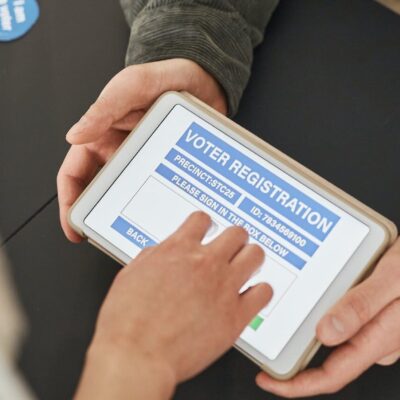
What you’ll need:
- Computer with internet access
- Detailed ballot contents
Getting started
The Voting Time Estimator will provide you with a reasonable estimate based on the contents of your ballot and your voting method (paper ballots or electronic voting).
The tool is easy and doesn’t require any preparation to use. Once you’ve got detailed information about what will be on your ballot, you can use the estimator.
Using the ToolUsing The Tool
The Voting Time Estimator will provide you with a reasonable estimate based on the contents of your ballot and your voting method (paper ballots or electronic voting).
The tool is easy and doesn’t require any preparation to use. Once you’ve got detailed information about what will be on your ballot, you can use the estimator.
Using the Estimator
Inputting your ballot contents
If you have the contents of your ballot, you’re ready to use the estimator.
Get started by visiting the Voting Time Estimator website.
To make an estimate, you need to input the number and type of contests on your ballot. You’re going to count the different types of races on your ballot and enter the numbers into the estimator. If you don’t have any of a type of race, you should enter 0.
Enter the number of contested races. Here’s an example from a sample ballot:
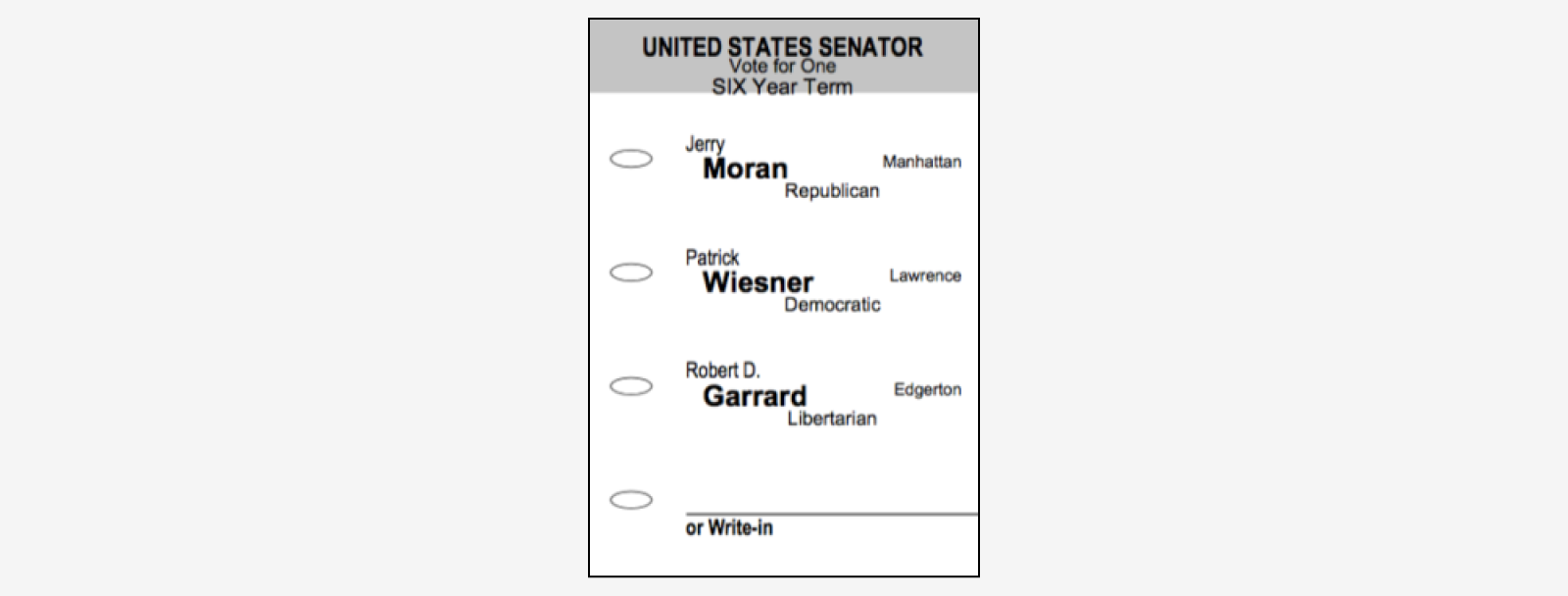
Enter the number of uncontested races. Here’s an example:

Enter the number of “multiselect” races, in which voters select more than one candidate. If you have none, enter 0. The example below contains 2 multiselect races, so we would enter 2 for the Number of such races field.
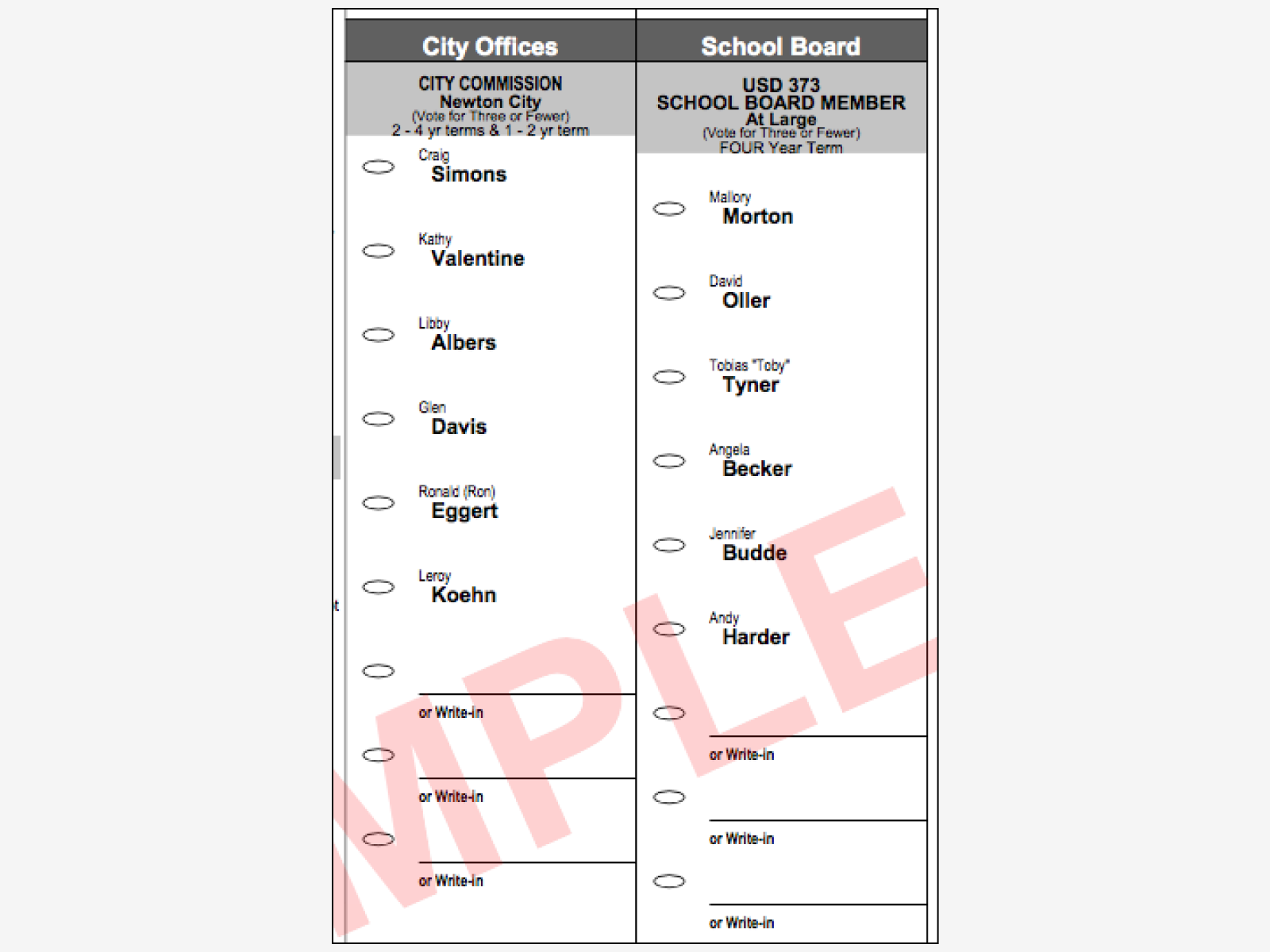
Still looking at any multiselect races on your ballot, enter the total number of selections the voter may select in all multiselect races in the Total selections in all field. Since we have 2 such races, and in each race the voter makes 3 (or fewer) selections, we enter the number 6 for this field. If you have 0 multiselect races, you should also enter 0 for this field.
Enter the number of initiatives, referendums, or propositions. Here’s an example:

A typical initiative
Enter the number of yes/no retention votes. Here’s an example:

Finally, select your voting style — either paper ballots or electronic (DRE) voting.
If your polling places allow voters to vote either on paper or electronically, you should run the estimator twice — first with one voting style and then with the other — and compare the estimates.
With your ballot information entered, click the Calculate button to get your estimate. The estimator will provide a projected average vote time.

Understanding your estimate
Now that you’ve gotten an estimated average vote time, you may want additional information to better understand what your estimate means and how it was produced. In this section, we’ll address some frequently asked questions about how the estimator works.
What does my estimate mean?
The Voting Time Estimator provides a range of average voting times that are likely for your ballot and voting style. For our sample ballot, the estimator states that there’s a 90% chance that the average voting time will fall between 2.4 and 4 minutes, with the exact middle (and most likely) time being about 3.2 minutes.

The estimator represents the time range visually in a heat map. In our example, the heat map highlights the area between 2.4 and 4 minutes in orange-to-red, indicating that is the most likely range of averages for our ballot. The yellow color designates the extremes of the range. In almost all cases, your average time will fall within these extremes.
How does the estimator arrive at its predictions?
To make predictions, the estimator uses data on real voters and their actual vote times.
Lots of data, in fact.
With the help of many election officials and researchers, we have collected the actual time taken to vote for 11,990 voters in 21 states at 529 polling places with 196 different ballots over the course of 2 years.
Using this data, we came up with a set of formulas that accurately describe the average voting times for each ballot within something resembling a bell curve.
If you picture the red area in our heat map as the middle of the bell curve, that means that the formulas we derived accurately matched 90% of the measured averages within that red area — with most of them bunching up in the red middle section. You can imagine the orange-to-yellow areas as the extremes of the bell curve, and only about 10% of the actual results varied that far from the formulas’ predicted results.
The estimator works under the assumption that the formulas that somewhat accurately describe past voting times can also predict future ones.
Is the estimate universal? Will it apply to every voter and polling place?
The estimator provides an predicted average vote time, and individual voters’ times will vary much more widely than the averages.
Vote times can vary by polling place, too. We have found that, even with the same ballot and voting style, individual polling places can sometimes have vote times that differ as widely as the extremes our formulas predict. That means that it’s possible that, for our sample ballot above, one polling place could have an average time of 2.4 minutes while another has an average of 4 minutes.
Are there any particular kinds of ballots to watch out for?
You may find that some types of ballots have a wider range of predicted averages than others. In some cases, that’s because we don’t have enough data for that ballot combination to give us a more precise estimate. In other cases, it’s because the data so far tells us that it’s normal to expect a wider range.
We’ve found that with very short ballots, the estimator can be less precise than usual, although the actual variations in time are relatively small.
For example, working with a small ballot, even though the estimator may predict an average time of just 1 minute, the actual range measured likely fell somewhere between 30 seconds and 90 seconds. This means the estimate is off by as much as 50%. Fortunately, this only amounts to about 30 seconds off target.
We’ve also found that the estimator is less precise with ballots that include many (10+) initiatives or referendums. Be aware that for ballots like these, the estimator predicts estimate ranges that, unfortunately, can vary by several minutes.
As we collect more data on ballots like these, we hope to refine the predictions.
To help us continue to improve the estimator’s precision, consider collecting voting time data to contribute to this project! See the information about contributing data below.
Once you’ve got your estimate, consider its implications for Election Day. To understand how your estimated vote time can impact wait times at the polls, you can use your estimate with the Polling Place Resource Planner.
Using your estimate with the Polling Place Resource Planner
The Polling Place Resource Planner is a free simulation program to help you estimate resource needs at a polling place. You can read full instructions on the tool page, but our focus here is on using your voting time estimate with the planner.
Start by opening the web app version or the downloadable app version (.zip file, 135KB) of the planner.
With the planner open, prepare to calculate wait times by plugging information about your polling place into the 6 main inputs. For input 6, the average number of minutes a voter will take to vote, enter your estimate from the Voting Time Estimator.
Since our estimate was 3.2, we entered 3.2 into the avg. min. to vote field. We also input other details about our polling place and ran the simulation.
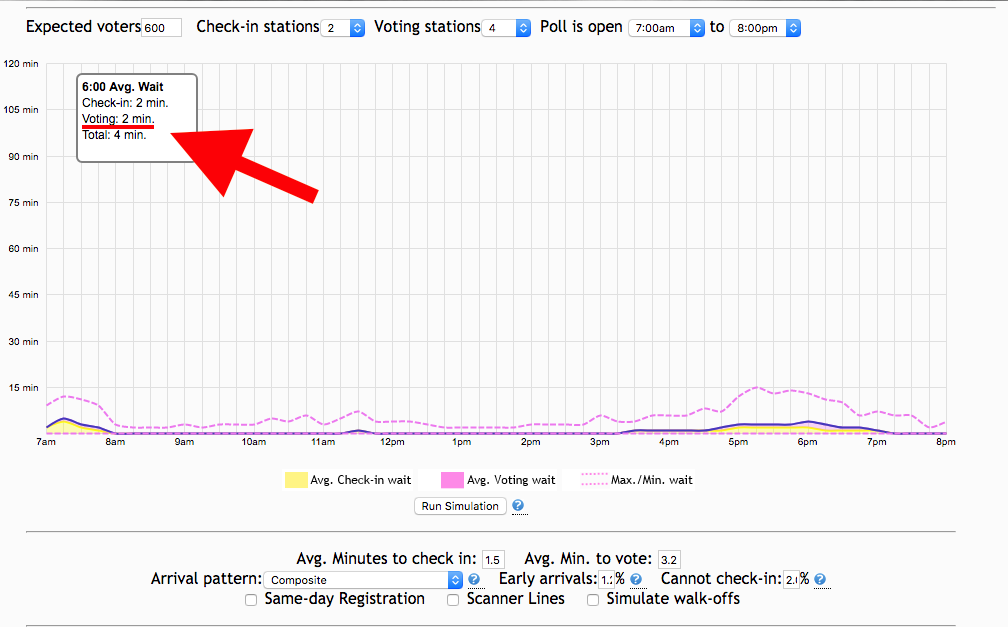
With an average vote time of 3.2 minutes, the planner predicts no more than 2 minutes as the average wait to vote — even during the busiest period of the day. The possible maximum voting wait, indicated with the dotted pink line, is about 15 minutes at its highest point.
So, we can conclude that our estimated average vote time of 3.2 minutes will not lead to significant waits at the polling place.
But, remember that your estimated vote time also comes with a range. To cover your bases, try running simulations using the times at the extreme ends of the range, too.
With our extreme low estimate of 2.4 minutes, the planner predicts 0 minutes as the highest average wait to vote and a maximum possible voting wait of about 10 minutes at its highest point.
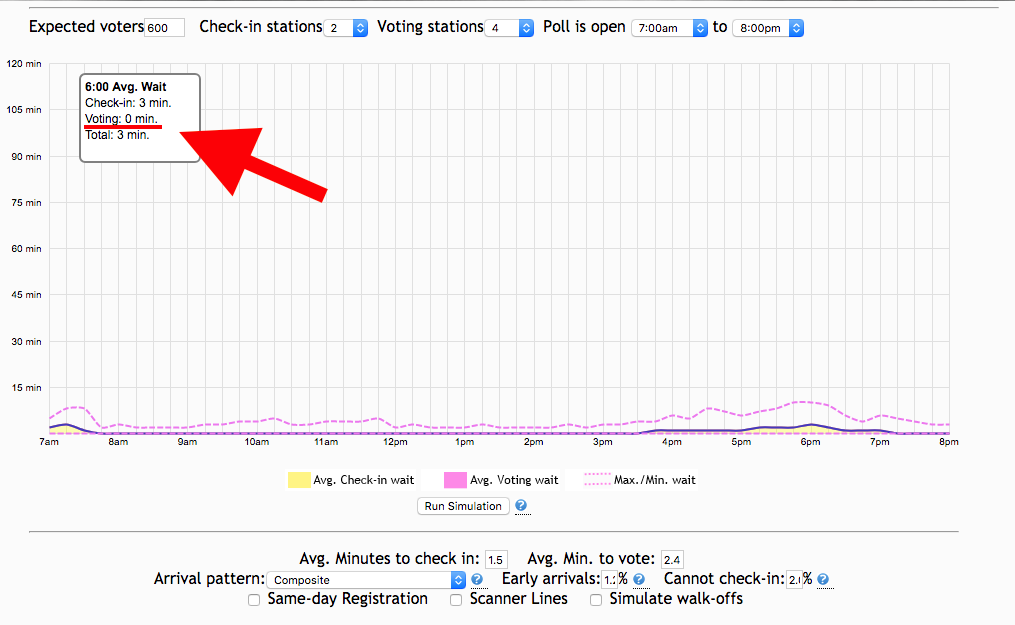
With our extreme high estimate of 4 minutes, the planner predicts 15 minutes as the highest average wait to vote and a maximum possible voting wait of about 45 minutes at its highest point.
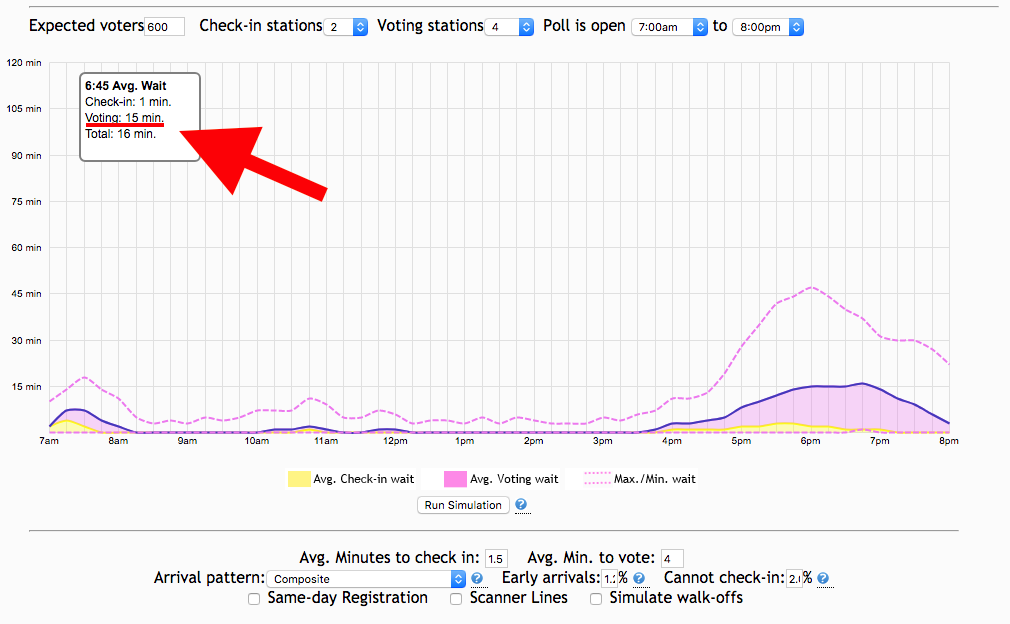
So, even with the extremes of the voting time estimate, our predicted wait times are generally reasonable. We can move forward with confidence that our ballot won’t lead to significant waits at this polling place.
If the planner did predict long waits, we might consider making changes to the polling place setup, including increasing the number of voting stations. To test how a change might impact wait times, just change one or more of the inputs and watch how the simulator adjusts.
Also be sure to keep in mind the average time to check in, indicated with the yellow part of the curve. In some cases, the number of check-in stations and average time to check in can lead to a check-in wait time. When this happens, it may mask issues with the number of voting stations. Remember that there can sometimes be a wait time to check in but not to vote, and if you take steps to reduce a bottleneck at check-in, the shift in traffic may cause lines to form at the voting stations.
Contributing data to improve this tool
Although the Voting Time Estimator gives estimates with a high degree of confidence, we’re continuing to improve it by collecting data on voting times. The more data we get, the more precise the estimator will be.
We invite you to advance research on voting times and help improve this tool by contributing voting time data yourself! The data that you contribute will benefit election officials across the country.
If you have data you’ve collected, or if you want to collect data using the simple, free Voting Timer App, get in touch with us at support@ElectionExcellence.org. We’re happy to provide support and address any questions you might have about collecting voting time data.
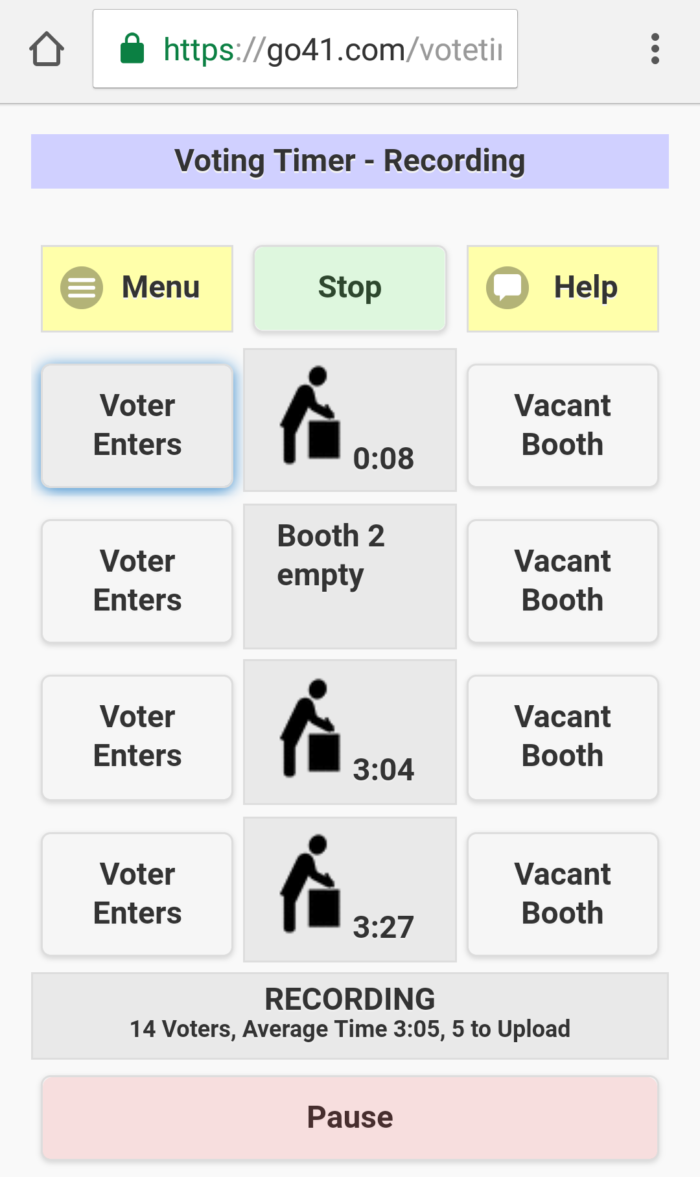
By collecting data, you’ll join this group of election officials and researchers who have generously provided data to help develop this tool. We thank them.
- Jonathan Aaberg — San Francisco, California Department of Elections
- Dayna Causby — Cleveland County, North Carolina Board of Elections
- Eric Fey — St. Louis County, Missouri Board of Elections
- Kammi Foote — Inyo County, California Clerk-Recorder-Registrar of Voters
- Heather Heyer — Denver, Colorado Elections Division
- Anna Leider — Alexandria, Virginia Office of Voter Registration and Elections
- Gretchen Reinemeyer — Arlington County, Virginia Office of Voter Registration and Elections
- Rob Rock — Rhode Island Department of State
- Charles Stewart III — Massachusetts Institute of Technology
- Grace Wachlarowicz — Minneapolis, Minnesota Elections and Voter Services Division


